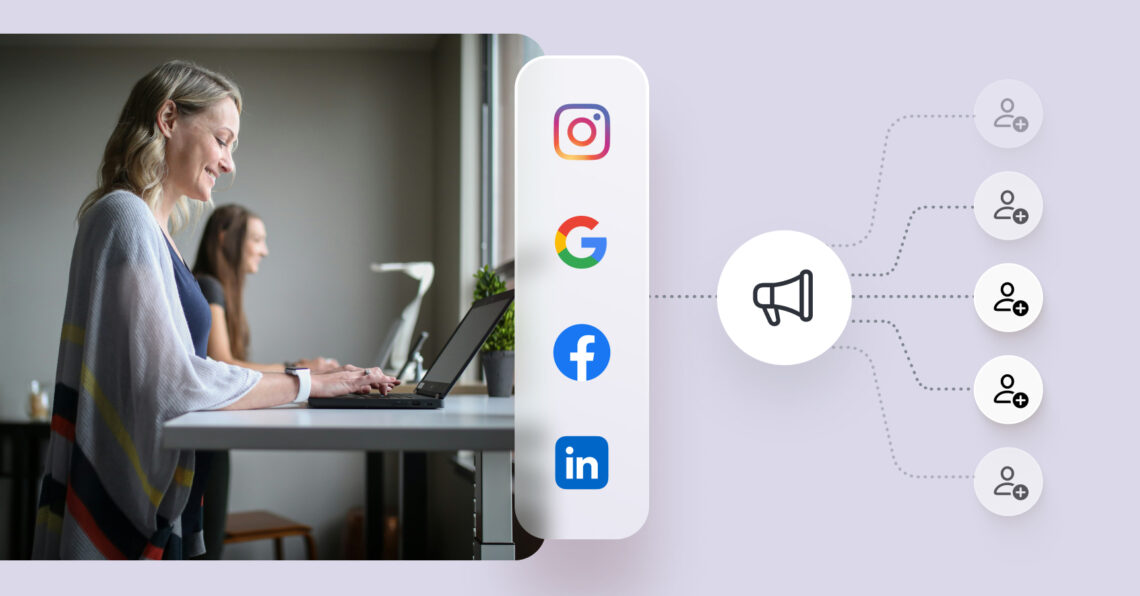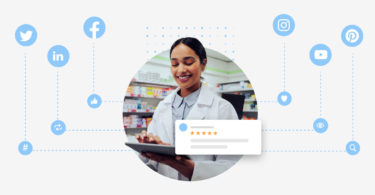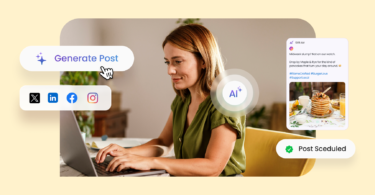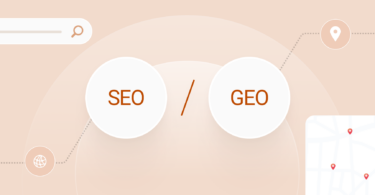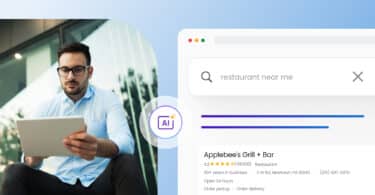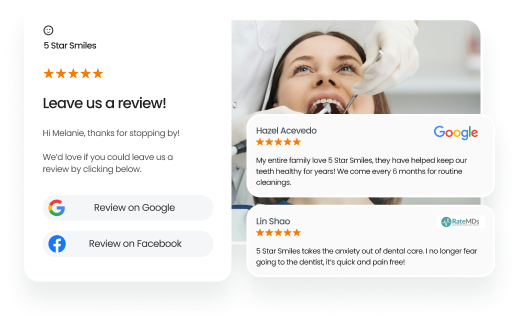As per Statista, social media now has 5.24 billion users, accounting for 63.9% of the global population. With such widespread use, these platforms offer businesses a powerful way to reach potential customers and generate quality leads.
Social media lead generation focuses on turning attention into action by capturing contact details from people who are likely to become customers.
When done effectively, it helps businesses reach the right audience, start conversations, and build meaningful relationships. A single post, ad, or message can lead to an inquiry, a demo request, or a sale.
But consistent posting alone won’t deliver results. You need a structured approach that combines relevant content, the right tools, and timing to guide people from initial interest to action.
This guide includes 12 proven social media lead generation strategies. Each one offers clear steps, real examples, and key metrics to help you improve how you attract and convert leads through your social channels.
Table of contents
- What is social media lead generation?
- Key benefits of using social media for lead generation
- Best social media platforms for lead generation: B2B vs B2C
- Step-by-step guide to capturing leads on social platforms
- Key metrics to measure social media lead generation success
- How CYM Living used Birdeye to generate leads from social media
- Moving forward with smarter social media lead generation
- Frequently asked questions on lead generation with social media
- How Birdeye Social AI helps with lead generation
What is social media lead generation?
Social media lead generation is the process of using platforms like Facebook, LinkedIn, and Instagram to find potential customers and collect their contact information. This is often achieved by sharing useful content, such as how-to videos, product guides, or industry tips, with clear calls to action. You can also offer something in exchange, like a free checklist, webinar registration, trial signup, or limited-time discount, to encourage users to share their details.
For example, a skincare brand might post an Instagram story offering a free skin type quiz. After completing the quiz, users enter their email to get personalized product recommendations. This way, the skincare brand can turn engagement into a qualified lead.
Key benefits of using social media for lead generation
Below are several reasons why this approach is essential for your social media lead-generation strategies:
Helps reach more people and keep them engaged
Social media platforms give you access to large and varied audiences. By posting regularly and interacting with users, your brand can become more visible and trusted. This leads to increased website traffic, higher content engagement, and more interest in your product or service.
Targets specific groups with relevant messages
Each platform offers tools that enable you to target social media users based on their location, interests, job titles, and more. With this targeting, your content can be shown to people who are most likely to become leads. This improves the quality of responses and helps make better use of your budget.
Scale lead generation efforts affordably
Social media campaigns can begin with modest spending. As results come in, you can adjust your budget, refine your content, and improve performance. This flexibility makes social media lead generation more affordable than traditional lead-generation methods.
Use data to improve your results
Platforms provide built-in analytics to help you understand how your campaigns are performing. You can track clicks, form submissions, and user behavior to learn what works best. These insights support better decisions and stronger lead quality over time.
Build relationships with potential customers
Social media allows you to respond to questions, offer useful information, and stay in touch with leads after their first interaction. This ongoing engagement helps build trust, which is important when guiding someone through the sales process.
Increase your brand visibility
When people engage with your content, it gets shared and seen by more users. This helps your brand reach new audiences and improves how people perceive your business. A strong social media presence can lead to more inquiries, more form fills, and better results overall.
Now that you know the benefits, let’s look at which social media platforms work best for lead generation.
Best social media platforms for lead generation: B2B vs B2C
Choosing the right social media platform is key to effective lead generation. Different platforms excel depending on your target audience and business type. The table below highlights the top platforms and the most effective tactics for generating leads in both B2B and B2C markets.
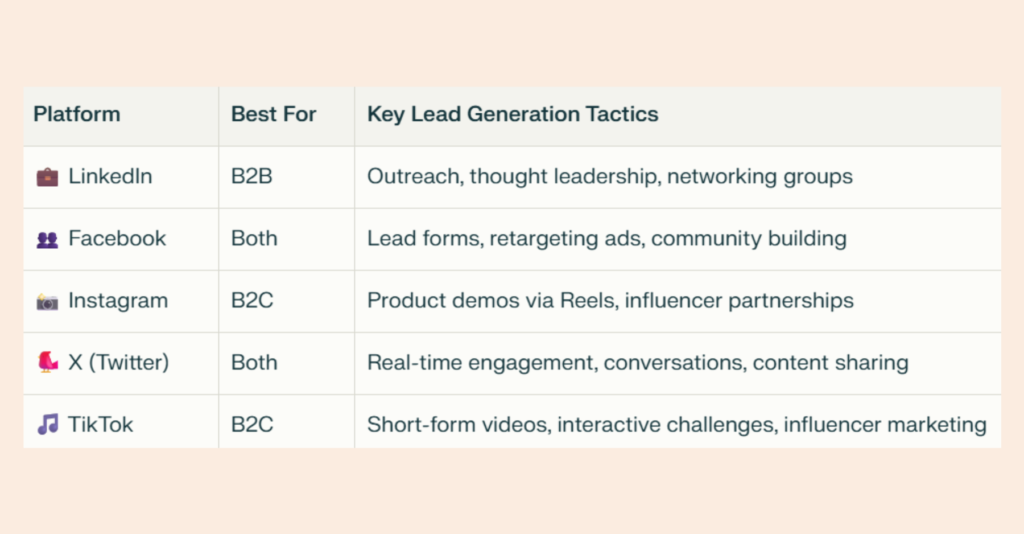
By leveraging the right platform with tailored tactics, businesses can maximize lead quality and conversion rates, making social media a strategic asset for growth.
Step-by-step guide to capturing leads on social platforms
Social platforms offer a direct way to reach people who may be interested in your product or service. But turning interest into actual leads takes a clear plan.
Let’s explore some reliable methods you can use to collect contact information and start meaningful conversations.
1. Start by setting up your social profile correctly
Begin with a clear profile that shows what your business does and how people can reach you. Include a short bio, a strong call to action, and a link to a contact or signup page. Use high-quality visuals that reflect your brand’s identity.
2. Share helpful and consistent content
To attract interest, post content that speaks to your audience’s needs. This could include tips, short videos, checklists, or FAQs. Keep your posts regular so people know when to expect new updates.
3. Use paid advertising to reach the right people
Here’s how to expand your reach. Platforms like Facebook and LinkedIn allow you to run social media ads based on location, interests, or job titles. You can also use native lead forms, allowing users to submit their details without leaving the platform.
4. Set up sequential retargeting ads
Sequential retargeting involves showing a series of ads to users based on their previous interactions with your website or ads. Instead of just one retargeting ad, you deliver ads in a specific order to progressively engage users and drive them closer to conversion.
For example, if someone visits a specific service page on your site but doesn’t take action, your first retargeting ad might offer a valuable resource related to that service (like a free guide). If the user interacts with that ad, you then show a follow-up ad with a stronger call-to-action, such as booking a free consultation or trial. Each ad is targeted based on the user’s stage in their decision-making process, creating a clear path toward conversion.
5. Run contests & host webinars to get quick responses

Giveaways, contests, and webinars are great ways to engage your audience and collect leads quickly. Ask users to enter contests by submitting their email, answering a question, or tagging others.
Hosting webinars can also attract interested participants by offering valuable live content, encouraging sign-ups, and direct interaction. Make sure the rewards or webinar topics are relevant to what you offer to maximize engagement.
6. Use lead magnets to get contact details
Offer valuable resources such as ebooks, templates, or free webinars to your audience in exchange for their email addresses. This helps you build a targeted contact list while providing a valuable resource. Make sure the offer is relevant and appealing to encourage sign-ups.
Note: Design a clean, distraction-free landing page. Use a clear headline, highlight the main benefit upfront, and keep the form short, so visitors immediately understand why they should share their contact details.
7. Share testimonials as social proof
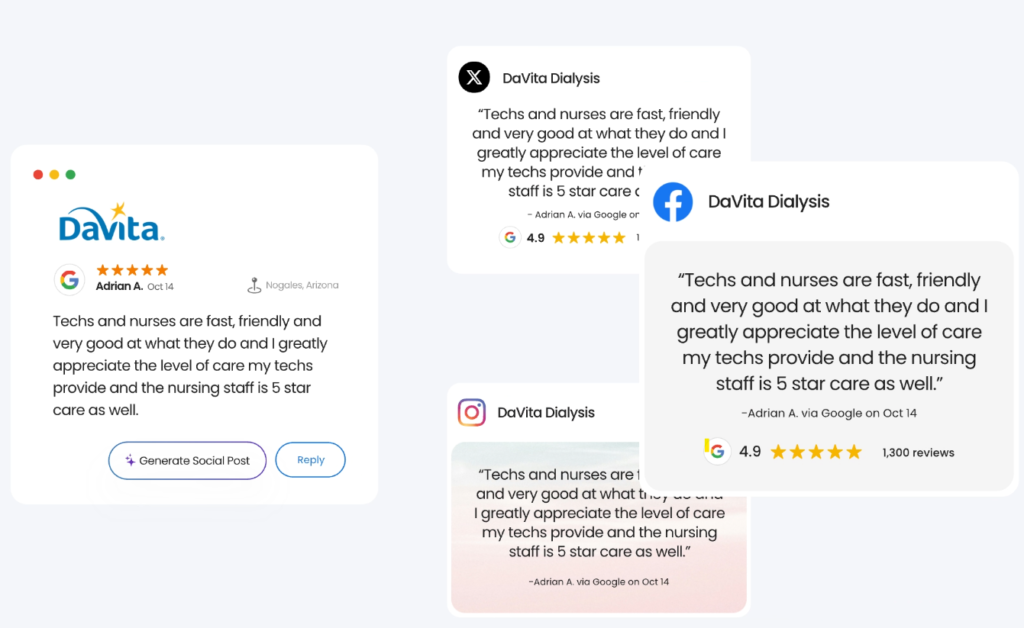
Social proof builds trust and encourages more people to engage. Share customer reviews, success stories, or video testimonials that highlight real results with your product or service. Keep these posts genuine and include links or calls to action so interested viewers can learn more or sign up.
8. Collaborate with influencers and explore sponsorships
Influencers already have audiences that trust their opinions. Partnering with relevant influencers to promote your lead magnets, webinars, or events can expose your brand to potential leads who are more likely to pay attention and take action.
Additionally, consider sponsoring influencer content or events to further boost visibility and credibility within your target niche. For instance, an influencer might feature your free guide or checklist in the description of a sponsored YouTube tutorial, or promote your upcoming webinar through a series of Instagram Stories with a swipe-up link for easy registration.
9. Launch a referral campaign
Encourage your current followers or customers to refer new leads by offering a small reward or incentive, like a discount, gift card, or bonus product. Make the referral process simple and clearly explain how it works to maximize participation.
10. Listen and respond to conversations
Use social listening to monitor what people are saying about your field across platforms. This means staying alert to relevant discussions, questions, and trends. By replying to questions, joining open conversations, and offering thoughtful comments that demonstrate your expertise, you build visibility and open the door to new connections.
11. Use advocacy to let your team spread the word
Your employees and close partners can be strong supporters on social media. Encourage them to share lead generation posts or invite their networks to download a resource or join an event. Provide ready-made images or captions to make sharing easy, and recognize their efforts with shoutouts or incentives.
12. Be present and stay responsive
Respond promptly to comments and messages. A quick reply shows that your brand is active and interested. Over time, these small actions help build trust and encourage people to take the next step.
Generating leads through social media takes consistency, valuable content, and clear communication. When your profiles are well set up and your messaging is focused, it’s easier to turn followers into qualified leads.
Explore Top Social Media Lead Generation Strategies
Want to see the impact of Birdeye on your business? Watch the Free Demo Now.
Key metrics to measure social media lead generation success
Measuring the right social media metrics is essential for understanding how well your efforts attract and convert potential customers. Lead generation metrics serve as key performance indicators (KPIs), indicating how effectively your campaigns convert followers into high-quality leads. Tracking these metrics helps you refine your strategy and maximize ROI.
Here’s a breakdown of the most important metrics to focus on:
1. Engagement metrics
- Click-through rate (CTR): The percentage of users who click on links in your social posts, indicating interest beyond likes or comments.
- Website traffic: Measures how many visitors arrive at your website through social media channels.
- Bounce rate: The percentage of visitors who leave your site quickly after viewing only one page, indicating engagement quality.
- Time on page: Tracks how long users spend exploring your web pages, helping gauge content relevance.
2. Lead generation metrics
- Number of leads generated: Total leads captured directly from social media marketing activities.
- Lead conversion rate: The proportion of these leads that successfully convert into paying customers.
- Lead quality: Evaluate the potential value of leads based on demographics, behavior, and engagement.
- Cost per lead (CPL): The expense incurred to acquire a single lead through social media campaigns.
- Customer acquisition cost (CAC): Overall cost to acquire a new customer, including all marketing, sales, and overhead expenses.
- Marketing qualified leads (MQLs): Leads deemed sufficiently interested and ready to be passed to sales for nurturing.
- Sales qualified leads (SQLs): MQLs that are further vetted by sales and considered ready for direct outreach.
3. Additional key metrics
- Cost per click (CPC): The price paid for each click on your social ads.
- Return on ad spend (ROAS): Revenue generated for every dollar spent on advertising.
- Customer lifetime value (CLTV): Estimated total revenue from a customer during their entire relationship with your brand.
4. Supporting metrics
- Engagement rate: Reflects how actively users interact with your content, including likes, comments, shares, and reactions.
- Follower growth rate: Tracks how quickly your social media audience is expanding.
- Impressions: The total number of times your content is displayed to users.
- Reach: The count of unique users who have seen your posts.
- Social share of voice (SSoV): Measures how often your brand is mentioned on social media compared to competitors.
How CYM Living used Birdeye to generate leads from social media
CYM Living used Birdeye Social AI to manage social media across 80+ property locations. They scheduled posts in bulk, personalized content for each community, and used AI tools to create timely updates without overloading their team. This helped them keep a consistent presence while saving time on daily tasks.
They also turned positive resident reviews into posts and ran seasonal promotions to collect contact details from interested prospects. As a result, they saw a 13.3% increase in engagement and gained around 360 new followers each month, many of whom converted into leads through forms and direct messages.
Moving forward with smarter social media lead generation
Social media lead generation will continue to adapt as platforms introduce new features and user habits shift. What remains important is maintaining a clear strategy, offering value in exchange for attention, and responding promptly to interest.
Businesses that stay consistent, test new formats, and listen to their audience will be better positioned to collect relevant leads and build long-term interest.
Frequently asked questions on lead generation with social media
Social media lead generation is the process of attracting, engaging, and converting potential customers using platforms like Facebook, Instagram, LinkedIn, and others.
Social media is a major source of information and interaction for consumers. It allows businesses to reach their target audience, build trust, and generate high-quality leads effectively.
The best platform depends on your target audience. LinkedIn is typically best for B2B companies, while Facebook, Instagram, and TikTok are more effective for B2C marketing.
Content that performs well includes videos, blog posts, downloadable resources like ebooks, webinars, and customer case studies.
Use strategies such as offering lead magnets, running targeted ads, and using lead generation forms provided by social media platforms.
You can measure success by tracking metrics such as click-through rate, conversion rate, cost per lead, and the total number of valuable leads generated.
How Birdeye Social AI helps with lead generation
Social media lead generation can be difficult to manage across multiple platforms and business locations. Birdeye Social AI simplifies this work by helping businesses plan, create, publish, and track content more efficiently while keeping communication consistent and focused.
Create content that matches your audience and brand
Birdeye’s Social AI agents generate content that reflects your brand style and speaks directly to the needs of your audience. Content can be customized for different services, regions, or communities, helping your message stay clear and relevant.
Publish across multiple locations with built-in efficiency
Bulk publishing tools make it easy to post across several channels. Personalization features allow for automatic adjustments to reflect local contact information, city names, or services. This saves time while keeping the content meaningful for each audience.
Plan and organize with a shared content calendar
An easy-to-use visual calendar helps marketing teams schedule and manage content across all platforms. It supports filtering by account, location, or post status. A built-in content library also gives teams access to pre-approved posts for quick use.
Manage engagement from one central inbox
Comments, messages, and replies from all social media accounts appear in one place. Teams can respond quickly to questions or feedback and keep communication going with potential leads. Quick responses help keep users interested and connected to your brand.
Track what is working and adjust with data
Birdeye provides analytics and reporting tools that show performance across channels and locations. You can track post engagement, audience growth, reach, and conversions. Competitor reports give added context to help you make smarter content decisions.
Birdeye Social AI helps teams stay organized, reduce time spent on routine tasks, and improve the way they use social media to capture interest. With consistent content and timely communication, businesses are better positioned to turn attention into real opportunities.

Originally published
